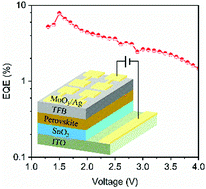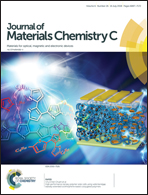Efficient perovskite light-emitting diodes based on a solution-processed tin dioxide electron transport layer†
Abstract
To achieve high-performance perovskite light-emitting diodes (PeLEDs), an appropriate functional layer beneath the perovskite emissive layer is significantly important to modulate the morphology of the perovskite film and to facilitate charge injection and transport in the device. Herein, for the first time, we report efficient n–i–p structured PeLEDs using solution-processed SnO2 as an electron transport layer. Three-dimensional perovskites, such as CH(NH2)2PbI3 and CH3NH3PbI3, are found to be more chemically compatible with SnO2 than with commonly used ZnO. In addition, SnO2 shows good transparency, excellent morphology and suitable energy levels. These properties make SnO2 a promising candidate in both three- and low-dimensional PeLEDs, among which a high external quantum efficiency of 7.9% has been realized. Furthermore, interfacial materials that are widely used to improve the device performances of ZnO-based PeLEDs are also applied on SnO2-based PeLEDs and their effects have been systematically studied. In contrast to ZnO, SnO2 modified by these interfacial materials shows detrimental effects due to photoluminescence quenching.



 Please wait while we load your content...
Please wait while we load your content...